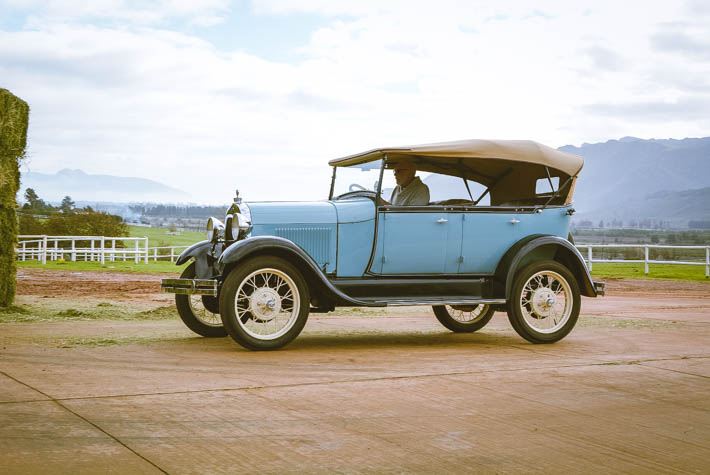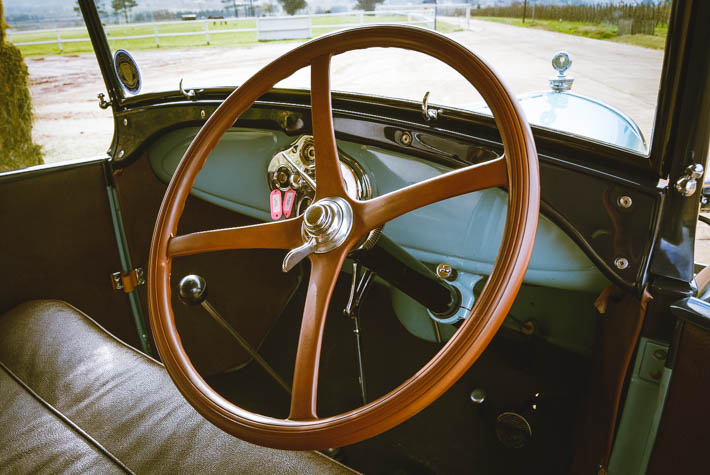
24 Jun COLLECTION IN ACTION – F

An alphabetical series of short driving impressions of some of the museum’s car collection. This month we go revive the Roaring ’20s in a classic Ford model A.
As motoring pioneers go, Ol’ Henry Ford ranks as one of the finest, not for having any superior engineering or ground-breaking design achievements, but more for his business and manufacturing acumen – and a desire to create affordable cars for the masses. The mass-produced Model T set standards that the automotive world was only too glad to emulate. So when his next ‘people’s car’ emerged late in 1927, everyone expected something special. It was named the Model A but, a little confusingly perhaps, it was not the first with this moniker. The previous Model A was Ford’s first-ever car, built in 1903/04, and while subsequent models were identified alphabetically, the follow-up to the T reverted to Model A because the new car was such a departure from the old that Henry wanted to start over again.
The motoring public were certainly not disappointed. The second Model A boasted a water-cooled 200,5ci (3 285 cm3) four-cylinder L-head engine developing 40 hp (30 kW) at 2 200 r/min. Fuel was gravity-fed from a cowl-mounted tank and the compression ratio was a mere 4,22:1. The drivetrain comprised a conventional non-synchronised three-speed-plus-reverse, sliding gear manual gearbox, a multi-plate dry clutch, and shaft drive to the live rear axle with its final drive ratio of 3,77:1. Four-wheel mechanical (internal expanding) drum brakes were used.
In cooler climates, owners could purchase a cast iron cover for the exhaust manifold that provided heat to the cab via a small vent. Other highlights included a safety glass all round, a contemporary battery and ignition system, and the paintwork was highlighted with contrasting colours and pin-striping. A rear-view mirror was amongst the list of optional extras.
Chassis-wise, the Model A had a 103,5-inch (2 629 mm) wheelbase and rode on semi-elliptic leaf springs front and rear but with Houdaille double-action hydraulic shock absorbers. Tyres were 4.50×21 on wire spoke wheels. The Model A was the first Ford to use the standard set of driver controls with conventional clutch, brake and (centrally placed) accelerator pedals.
This model was the cheapest in the range and sold for $460. Climbing aboard the sky blue A requires some wriggling if, like me, you are of above average height. Once seated – it is cramped – there is a terrific, elevated view through the flat screen and out of the open sides. Turn the key, curl your left leg around the gearshift and depress the floor-mounted starter button and the motor chugs into life with a steady beat of a low-stressed big-capacity motor.
Engage first – left and back – and the Model A pulls away with some vigour. Max torque of 173 N.m arrives at just 1 000 r/min that that helps the 970 kg Phaeton to quickly get up to cruising speed and lug away contentedly. Which is just as well because once in the 2-3 plane to the right of the H-pattern gate, the gear knob sits in the crook of your left knee. But never mind the contortions; driving the Model is a grin-inducing experience. The ride is comfortable and the steering easy to manage thanks to the large, four-spoke wheel. It is easy to understand the car’s enduring popularity
Production began on 21 October 1927 when the engine was fitted to the first A to be assembled. Sales commenced on 2 December, so FMM’s 1928 four-door Phaeton is one of the earliest to be built. In that first year, nine different models were produced and by 4 February 1929, one million Model As had been sold. By 24 July the two-million mark was reached, and by March 1930 the figure was three million.
When production ended in March 1932, a staggering 4 858 644 Model As had been made – one list shows 36 different body styles had been used over its model life. Some 124 024 Phaetons were produced. The Model A was a second huge success for Ford and carries a massive following to this day. That such a well engineered – and in some instances innovative – car built in an industry-leading flexible mass production manner with enviable quality and reliability is a lasting tribute to Ol’ Henry’s foresight. MM



